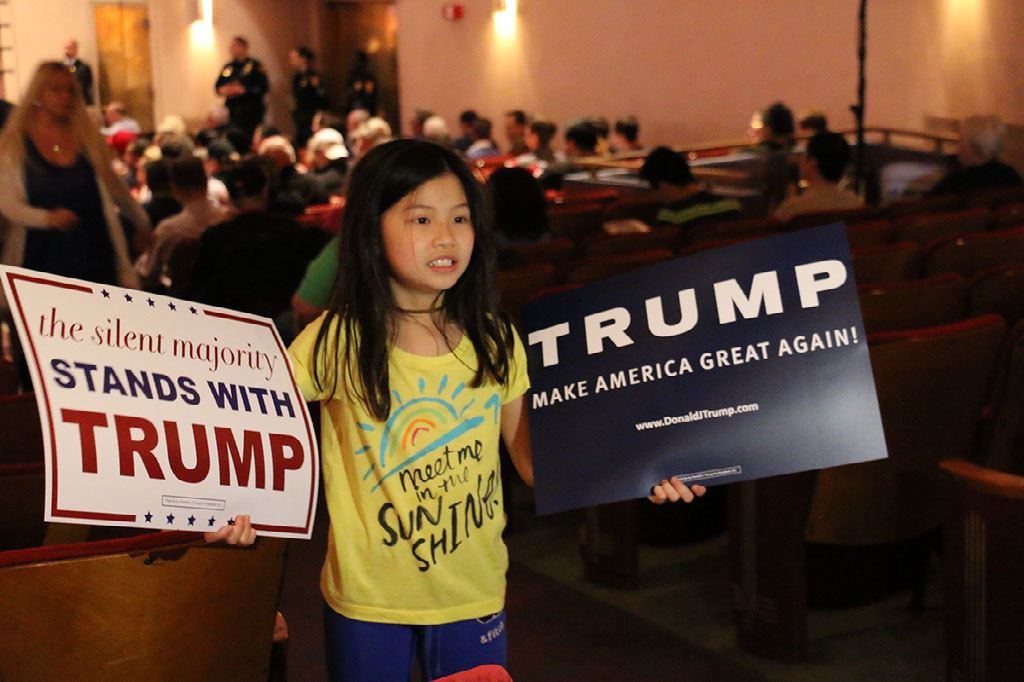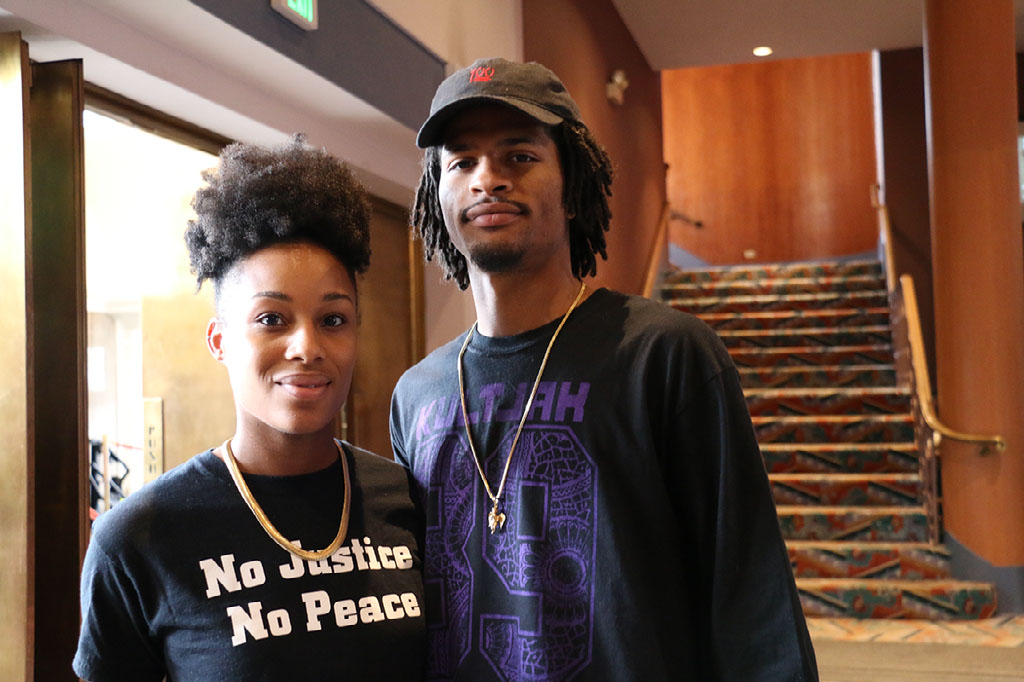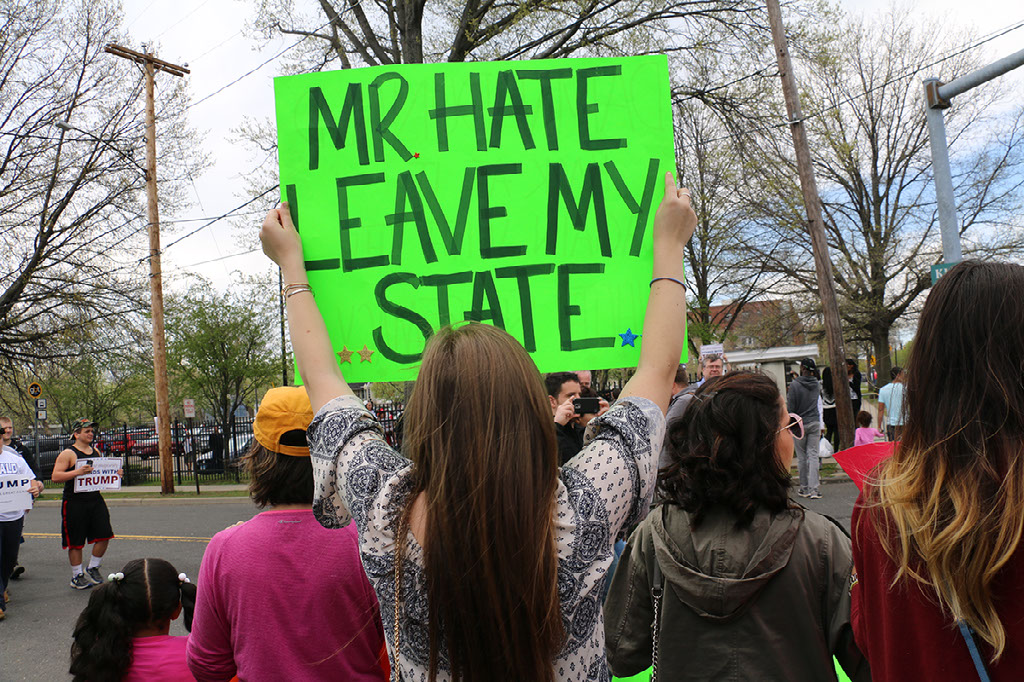The show goes on: The Trump phenomenon is more entertaining— and dangerous—than Trump himself
Article by Margaux MacColl '16 and photos by Channing Smith '17
“Let’s bring waterboarding back. Let’s find out everything the terrorists know,” Carl Higbie, a former Navy Seal, said to the crowd of hundreds at the Klein Memorial Auditorium in Bridgeport. “Then let’s waterboard them some more.”
A man sitting to my left turned to me laughing, “This is going to be fun.”
Higbie was an opening speaker at the April 23 Donald Trump rally. Trump, perhaps the most controversial 2016 Republican presidential candidate, had yet to take the stage, but the show had already begun. While it was a political rally, the atmosphere was that of a contentious football game.
Within 60 seconds of the first introductory speech, the crowd erupted into “boo’s” at the mention of democratic Governor Dannel Malloy.
“People usually react kind of fast,” a reporter in the media section said in shock. “But never that fast.”
Indeed, many of the Trump supporters were quick to be vocal. Many of them felt they had reason to be.
“My parents are legal immigrants. They have to work harder for jobs,” Stanislaw Godlewski, a student from Fairfield, said. “[Trump] doesn’t want immigrants to take our jobs.”
Lily Wunsch, a middle school girl from Rhode Island who donned a red shirt with a giant T on it, felt Trump was misunderstood.
“[My classmates] think he’s racist but they’re not at all informed,” she said. “He wants illegals out, and immigrants coming in. Illegal isn’t a race.”

But believing in Trump’s ideals wasn’t the only reason to attend the event. As the presidential candidate himself would later say, “What’s more fun than a Trump rally?”
When I saw Brandon Rakowski ’16, a student at Weston High School, later in the rally, the first thing he said to me was, “Are you here for the same reason I am?”
He meant he was there as joke, just to see the spectacle. He was hardly the only one; when a chant crescendoed throughout the room, you could see dozens of people chuckling, joining in satirically.
There certainly was a lot to see. If Higbie was part of Act 1, what happened in between speakers could have been an entire act in itself. Although the crowd mostly consisted of Trump supporters and ambivalent jokers, there were a handful of people who caused a more divisive split: the protesters.
Before Trump entered the room, the music was suddenly interrupted by a loudspeaker announcement:
“If a protestor starts protesting in the area around you, please do not touch or harm the protester. To inform the officers of the location of the protestor, please hold your rally sign over your head and start chanting, ‘Trump! Trump! Trump!’”
This announcement was an obvious response to the infamous incident at a Trump rally in Chicago in March, which was canceled after several fist fights broke out amongst the crowd. I would find out later that, at the same Bridgeport rally, a protester was removed by security in a chokehold.
It was about half an hour after the announcement when the crowd all abruptly stood up, forming a giant circle around two people. Thunderous chants of “Trump! Trump! Trump!” flooded the convention center.
A young couple I had previously interviewed were escorted by police officers out of the crowd.
The man, Kashawn Harold, said they came, “To see the madness with our own eyes.”
I rushed to the doors, hoping to speak to them again, but I was blockaded by dozens surrounding them, watching as they were forced out. The couple had gone from being spectators, to being the entertainment themselves.
The last thing I saw was their silhouettes walking down the front steps as the doors slammed closed.

The fascination with their exit was short-lived as attention turned to the main event.
Oddly enough, when Trump finally did arrive, it was almost as if his presence wasn’t needed. He skimmed over policies-- briefly mentioning his plans to build a wall along the Mexican border-- read some statistics about Bridgeport, and then did impersonations of Hillary Clinton and Ted Cruz.
Paul Manafort, Trump’s chief strategist, has been insisting that Trump was going to transition to a businesslike and tamed persona for the general election.
Trump seemed to be following the new playbook when talking about lack of industry in Bridgeport, saying, “We’re not angry.”
A woman in the crowd interrupted him, screaming, “Yeah we are!”
It was clear in that moment that Trump’s popularity stood, at least partially, on a foundation of anger. If he chose to unclench his fists, it was uncertain if the crowd would still follow him. Maybe that’s why he backtracked just a few minutes later.
"I have to rant and rave. I have to keep you people going. Otherwise you're going to fall asleep on me, right?" he exclaimed, hands chopping away at the air.
When yet another protester was removed, one of approximately 12 people escorted out of the convention center, Trump even laughed and said they kept things “interesting.”
About 50 minutes later, Trump left the stage. But the show wasn’t over. The final act was outside, waiting just around the corner.
Around forty people-- a smaller crowd than the rallies normally draw-- were protesting. They chanted, “No hate in our state,” and held up posters that said things like, “You can’t get rid of immigrants-- where will you get your next wife?”.
One man, wearing a “Trump ’16” shirt, went up to a protester with his hands up in appeasement and said, “Hey man, we both want equal rights.”
The protester responded by screaming, “F*** Trump!”

That’s when I realized it wasn’t just Trump’s fans that could be irrational. The angry, illogical rhetoric poisoned both sides. And the people who had come to laugh had removed themselves from a political process that should rely serious, intellectual conversation.
I’m not commenting on Trump’s policies-- on supporters or detractors. I’m commenting on the political climate the envelopes him, a climate that even his own campaign manager has expressed a desire to end.
People are either angry, or watching the show. The joking calls blend with the battle cries, and it’s hard to distinguish what anyone’s saying when everyone’s screaming. If Donald Trump is a joke, then the punchline is the presidency.
If Donald Trump is a movement, then it’s time he becomes more than just entertainment.
After attending the rally, I didn’t learn much about politics. But, through my apparent lack of boredom, I realized one thing.
The show we came to see wasn’t Trump after all. The show was us. The show was the supporters who chanted, the protesters that yelled, the spectators that laughed, even the reporters who focused more on the spectacle than the substance.
The problem wasn’t Trump-- it was the anger, the irrationality he helped incite on every side.
I was pulling out of the parking lot when I heard a man yell something I think scares us all.
“It’ll linger,” he said. “It’ll never go away.”